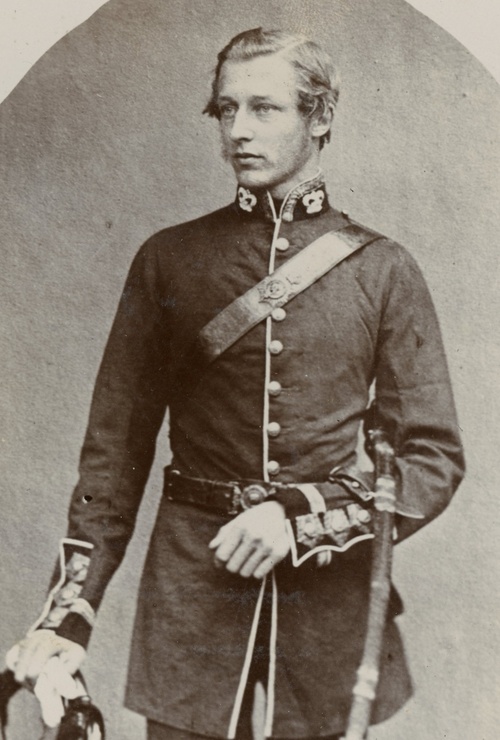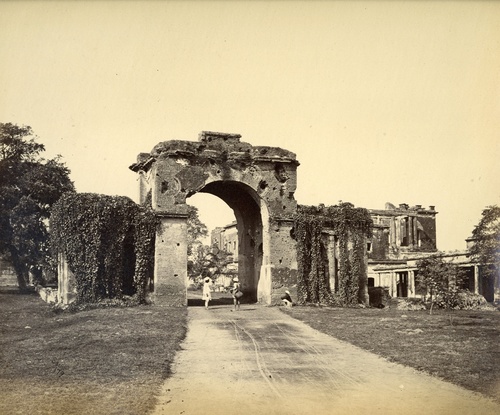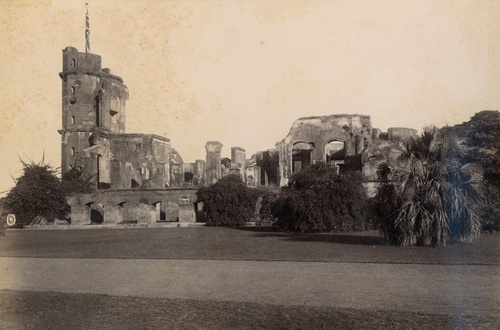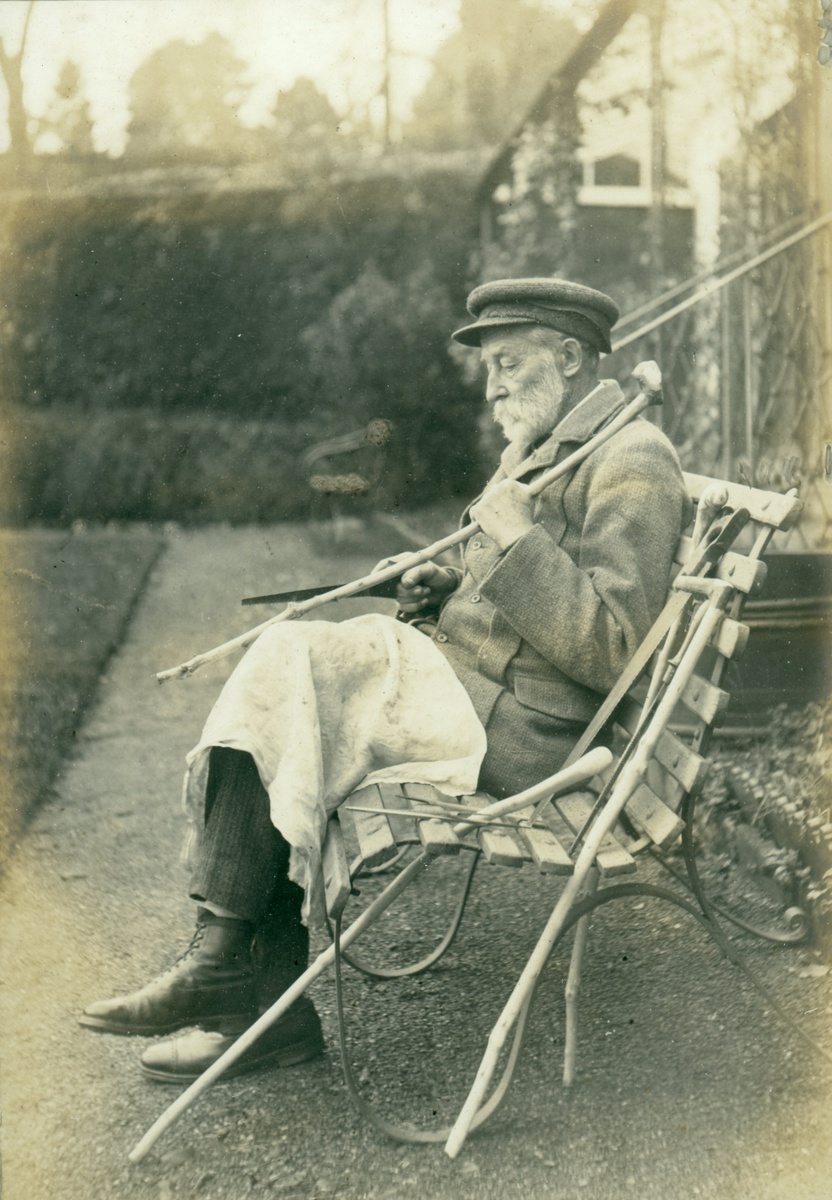Auction: 18001 - Orders, Decorations and Medals
Lot: 141
Sold by Order of a Direct Descendant
'We soon left the road and deployed in line on the plain, & advanced in skirmishing order over uneven ground, when the men struck out at quick step. We halted for a short time when the men were ordered to lie down.
Poor Haig was in the act of doing so when a round shot passed through his body. I was close by at the time and heard the horrid crash and saw him [struck down].
He was the first man I had seen killed & knowing him as I did, and having spoken to him recently, it quite shocked me. This kind of fighting went on for five hours until the enemy was driven from the Alumbagh.'
Assistant Surgeon Francis Collins on the heat of action at Lucknow.
The important Indian Mutiny Medal awarded to Assistant Surgeon F. Collins, 5th (Northumberland) Fusiliers
A hero of the siege of Lucknow his devotion to the wounded earned universal praise, a chapter of challenging active service recalled throughout his vivid hand-written account of the Mutiny
Indian Mutiny Medal 1857-59, 2 clasps, Relief of Lucknow, Lucknow (Staff Assistant Surgeon F. Collins, 5th Fusiliers), suspension sometime re-affixed, otherwise good very fine, mounted as worn upon a silver Phillips, Cockspur Street claw buckle
Housed in an attractive glazed wooden frame, 170mm. x 250mm., the medal accompanied by his 5th Northumberland Fusiliers officer's busby badge, 53mm. and his officer's sword-belt buckle, 52mm. x 73mm.
Francis Collins was born at Kirkman Bank in Knaresborough, near Harrogate, on 13 December 1832. Educated at St. Peter's, York, he studied Medicine at Edinburgh University and graduated in August 1854.
Commissioned Assistant Surgeon in the 5th Foot (Northumberland Fusiliers) on 1 September 1854, Collins sailed to Mauritius to join the regiment five days later. The 5th sailed for China aboard H.M.S. Simoon on 19 June 1857, but upon reaching Singapore, and on account of the impending news from India, they were diverted to Calcutta, arriving there on 4 July. Collins confirmed these developments in a letter to a friend:
'I write to you in a great hurry. We arrived here [Singapore] on Friday 19th on our way to Hong Kong, when we received orders to journey with all haste to Calcutta instead, in order that we may have a stab at the Sepoys, several Regts. having mutinied in Bengal.'
Collins was to perform a vital role in the trials to come.
The Siege of Lucknow
The princely state of Oudh, which straddled the Ganges in the north of India, had been made a British protectorate in 1816. Oudh became known as 'the nursery of Sepoys', since it supplied the East India Company's Bengal Army with around two-thirds of its native troops. On 7 February 1856 Lord Dalhousie, Governor-General of India, ordered the deposition of the King of Oudh, Nawab Wajid Ali Shah, on the grounds of alleged misrule. Despite travelling to London and pleading his case with Queen Victoria, the kingdom was soon annexed by the British. This brazen occupation caused the Sepoys of Oudh to mutiny at Meerut on 10 May 1857. The uprising spread to Lucknow, Oudh's capital, on 30 May.
Sir Henry Lawrence, as Chief Commissioner of Oudh, ordered the construction of a perimeter around the Governor's Residency at Lucknow on 23 May. The resultant enclosure, covering 60 acres of ground, was to be defended by a garrison of only 1,538 British and Indian soldiers, including the bulk of the 32nd Regiment of Foot, with 160 civilian volunteers. Within the garrison were about 1,300 non-combatants, including hundreds of women and children. While the 32nd Foot were initially able to drive the mutineers from Lucknow, the rest of Oudh fell into rebel hands following mutinies of Sepoy regiments at Sitapur, Faizabad and Daryabad in early June.
On 30 June, a rebel force of about 5,000 infantry, 800 horse and at least 12 artillery pieces descended on Oudh's capital. Its commander, Barkat Ahmad, adopted a strong defensive position near the village of Chinhut, eight miles north of the city. Lawrence's Intelligence Department, unaware of the true strength of Ahmad's force, rashly advised an attack. The disastrous engagement that followed greatly reduced the British force and enabled many of Lawrence's Sepoys to defect to the mutineers. A general rout ensued. Lucknow's defenders streamed backed to the Residency compound which the mutineers quickly surrounded. The siege began in earnest.
Lawrence was killed by a rebel shell which exploded in his Residency quarters on 2 July. Colonel John Inglis of the 32nd Regiment succeeded as commander of the garrison, having been instructed by Lawrence on his deathbed to 'never surrender'. The Residency garrison repulsed every assault by the mutineers, whose numbers had swelled to 8,000, for the next twelve weeks. This was despite an outbreak of cholera and incessant sniper fire from buildings in rebel control.
The First Relief
On 6 July, the 5th Fusiliers sailed from Calcutta to Chinsurah to be outfitted for active service. Ten days later they embarked for Allahabad onboard the river steamer Benares, sailing up the Ganges. The 5th formed part of Sir James Outram's column which united with a beleaguered force under General Havelock at Cawnpore in early September. The combined force numbered just over 3,000 men, nearly four-fifths of whom were British regular infantry. On 18 September, the vanguard of this force crossed the Ganges and made for Lucknow. Collins, keeping a diary of these events, recorded:
'On Saturday, the 19th, we left Cawnpore with the idea that no time should be lost in reaching Lucknow, but that we should be too late to relieve our unfortunate countrymen. We were roused from our sleep at 2:30 by the rivillée [sic.] & were soon all dressed and having breakfast.
We marched to the bridge of boats built about two miles off for the purpose of our crossing … The 5th Fusiliers, Madras Fusiliers & 84th Foot with Major's Syre's Battery formed the 1st Brigade, commanded by Brigadier-General Neill. When the whole force, numbering some 2,500, had crossed and taken up their positions, a few companies were sent out from different Regiments to skirmish in a large tract of hilly ground where the enemy was.
The enemy was playing upon us with a heavy fire from a battery exactly opposite us, not more than 600 or 700 yards distant, I should say. I was on horseback with Major Simmons, standing to the right of the line, when the first shot came over our heads with a tremendous hiss.'
Collins' diary reveals that the Havelock-Outram force was continually opposed as it marched through hostile Oudh to Lucknow. The rebel force besieging Lucknow had swelled to 15,000, and was entrenched in strong positions encircling the Residency. On Sunday 22 September, Collins wrote that he 'could distinctly hear the firing at Lucknow', and felt 'more than ever anxious for the safety of the survivors.' His diary takes up the story with a costly engagement:
'We were marching first in column of sections prior to leaving the road, when a round shot came ricocheting along the ditch to the left of the road; then came a second whizzing close over our heads, which killed a Captain of the 90th, and wounded officers close behind us; then another followed in close succession.
We soon left the road and deployed in line on the plain, & advanced in skirmishing order over uneven ground, when the men struck out at quick step. We halted for a short time when the men were ordered to lie down.
Poor Haig was in the act of doing so when a round shot passed through his body. I was close by at the time and heard the horrid crash and saw him [struck down]. He was the first man I had seen killed & knowing him as I did, and having spoken to him recently, it quite shocked me.
This kind of fighting went on for five hours until the enemy was driven from the Alumbagh.'
Collins then describes the relief of the Residency on 25 September, noting in great detail the part played by the 5th. Collins advanced towards rebel-occupied houses at the head of two companies, both of which were decimated by musketry and grapeshot. He was standing beside Sir James Outram when the famous order was cried: '5th - Charge the Guns!'
They duly did so, as Collins continues:
'[Major] Simmons immediately gave the order to advance on the guns. About a hundred yards further was a looped house inside a low walled garden, the wall was also loop-holed from which they kept up a sharp fire of musketry.
The men fired a volley against the walls with the folorn hope that some stray bullet might enter the loopholes and kill the cowards sheltered behind.
We lost that day 600 killed and wounded & 48 officers.'
The relieving force charged 'a gauntlet of bullets' until they reached the Residency compound, whose grateful defenders welcomed them with fervent 'Bless You's'. The casualties sustained by Havelock's force were so great, however, that the combined British forces were too weak to break out of the city. Lucknow's garrison had been augmented, rather than relieved. The siege continued, and Collins' medical training was in great demand. His diary records:
'The hospitals here are miserable, staff deficient, no food for sick men, no clothing; and the consequence is that many poor fellows, who could probably recover with proper treatment and nutritious food, die off from sheer filth and starvation.
Very few amputation cases have recovered; you will be shocked with the bill of mortality within the trenches of Lucknow when it reaches you. I am afraid to say how many in case I should exaggerate, but I know it is something tremendous.
The 5th, out of 13 officers, lost two killed, two dead of wounds, and three wounded; one of the latter though not seriously wounded, is now dying, the doctors say for want of proper nourishment. It is a sad state of things and you may imagine with what anxiety we are looking for reinforcements.'
The hospital at Lucknow would have been under continual bombardment from rebel-held buildings overlooking the Residency perimeter, and Edwardes writes that many of Collins' patients who were near to recovery were shot in their beds by snipers (Edwardes 1973, 89).
It was not until 17 November that the Residency was finally relieved, or rather evacuated, with the arrival of Sir Colin Campbell's army. Collins' diary continues right up to the eventual capture of Lucknow city on 21 March 1858, his handwriting becoming noticeably neater and more legible as his ordeal drew to a close. After the Mutiny, Collins' commanding officer wrote to him:
'We shall always remember your zealous and indefatigable attention to your medical duties, particularly during the arduous and trying circumstances of the late Indian campaign; and I have great pleasure in bearing testimony to the excellent manner in which, under constant exposure and difficulty, you performed all the duties of your profession.'
After the Mutiny
Collins left India on 16 November 1858, having been invalided, and returned to Mauritius. There he married Olympe Amélie Wiehé, with whom he was to have seven children. He then had a distinguished medical career in several branches of the Army. He was Assistant Surgeon to the Rifle Depot Battalion at Winchester from October 1859, before being transferred to the 18th Hussars in April 1860 and to the Royal Military College, Sandhurst in September 1860.
He was appointed Surgeon Major in 1864 and Staff Surgeon in 1867 and spent two years in Gibraltar before joining Netley Hospital as an Invaliding Medical Officer in 1870. He ended his army career as Assistant Head of Statistical Branch of the A.H.D. Whitehall Yard. His final posting was as Resident Medical Officer to Charterhouse School, a position he held from 1880-1884. He retired to Lyme Regis and died in 1925.
Sold with a quantity of original documentation, this of significant regimental and campaign importance, comprising:
(i)
A remarkable leather-bound pocket diary kept during the first relief and subsequent siege of Lucknow, with vivid descriptions of his service in the Residency compound and its hospital.
Three bound volumes of copied letters written by Collins to his family during the Indian Mutiny, entitled 'Letters Home, Written during the Suppression of the Sepoy Rebellion, 1857 to 1858'.
(ii)
A first edition of '1857' by Perceval Landon, published on the 50th Anniversary of the Indian Mutiny, inscribed to the recipient's son.
(iii)
Four commission warrants, comprising appointment as Assistant Surgeon, dated 1 September 1854; confirmation as Assistant Surgeon, dated 5 August 1859; appointment to Royal Military College Sandhurst as Assistant Surgeon, dated 21 September 1860; appointment as Surgeon, dated 9 March 1867.
(iv)
University of Edinburgh Medical School graduation certificate, dated 1st August 1854, and Edinburgh Medical Society certificate, 1853, both housed in their original tropical metal container designed to prevent deterioration in the tropics.
(v)
Further related medical certificates, comprising Royal College of Surgeons Diploma in Midwifery, 21 July 1854; Royal College of Surgeons medical examination certificate.
(vi)
St. George's Gazette, the regimental newspaper of the Northumberland Fusiliers, including a detailed obituary.
(vii)
A folder containing copied research on Collins, as well as a certificate of his marriage to Olympe Amélie Wiehé at St. James's Cathedral, Mauritius on 12 January 1859, and a booklet of testimonials written about Collins by his former comrades which he submitted to Charterhouse on applying for the position of Resident Medical Officer in 1880.
Please see Lot xxxx for the recipient's miniature dress medal and a portrait miniature.
Subject to 20% VAT on Buyer’s Premium. For more information please view Terms and Conditions for Buyers.
Sold for
£2,500











